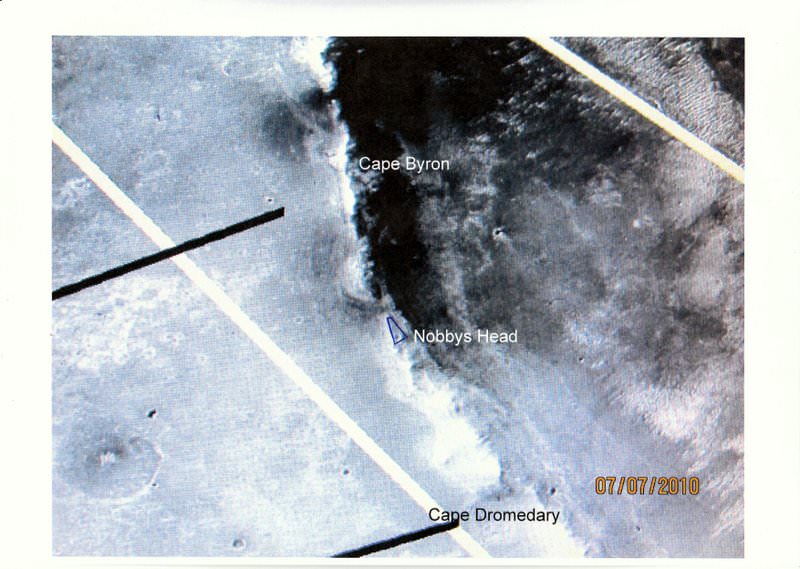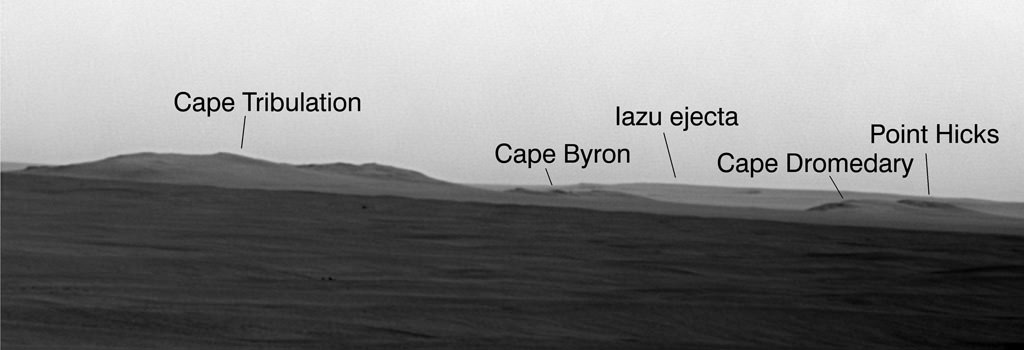Page 1 of 1
Craters around Endeavour
Posted: Wed Jun 30, 2010 9:46 am
by JohnD
As Opportunity approaches Endeavour, there are some remarkable pictures of the rim on the Rover site.
There is also a picture from orbit of the big crater with sight lines showing the promontories on the rim that Oppo is seeing.
But in and around Endeavour are a number of features that 'should' be smaller craters but that look like ponds in depressions in the plain!
See:
http://marsrover.nasa.gov/gallery/press ... map_br.jpg
Is this an illusion, caused by darkening of the ground around the 'ponds'?
A wind effect?
Or are these a different type of feature, sink hole, perhaps?
Thanks,
John
Re: Craters around Endeavour
Posted: Wed Jun 30, 2010 10:46 am
by rstevenson
Ponds? Craters, obviously. View the
large resolution image and you can clearly see sand dunes in the bottoms of many of them. As for the darker rims, part of that will be lighting effects, but part is also different colours of sands from different sources. There is a lot of very dark sand on Mars, which seems to be a different density than the lighter sands, so it deposits preferentially in different places. There's nothing very surprising about that -- after the fact, of course.
Another point: these images appear to have greatly enhanced contrast, the better to show detail. There wouldn't be nearly that difference in colour between the light and dark sands otherwise.
Rob
JPL: Mars Rover Seeing Destination in More Detail
Posted: Wed Jun 30, 2010 12:52 pm
by bystander
Mars Rover Seeing Destination in More Detail
NASA JPL (2010-217) 29 June 2010
Mars rover team members have begun informally naming features around the rim of Endeavour Crater, as they develop plans to investigate that destination when NASA's Opportunity rover arrives there after many more months of driving.
A new, super-resolution view of a portion of Endeavour's rim reveals details that were not discernible in earlier images from the rover. Several high points along the rim can be correlated with points discernible from orbit.
Super-resolution is an imaging technique combining information from multiple pictures of the same target to generate an image with a higher resolution than any of the individual images.
Endeavour has been the team's long-term destination for Opportunity since the summer of 2008, when the rover finished two years of studying Victoria Crater. By the spring of 2010, Opportunity had covered more than a third of the charted, 19-kilometer (12-mile) route from Victoria to Endeavour and reached an area with a gradual, southward slope offering a view of Endeavour's elevated rim.
After the rover team chose Endeavour as a long-term destination, the goal became even more alluring when observations with the Compact Reconnaissance Imaging Spectrometer for Mars, on NASA's Mars Reconnaissance Orbiter, found clay minerals exposed at Endeavour. Clay minerals, which form under wet conditions, have been found extensively on Mars from orbit, but have not been examined on the surface. Additional observations with that spectrometer are helping the rover team choose which part of Endeavour's rim to visit first with Opportunity.
The team is using the theme of names of places visited by British Royal Navy Capt. James Cook in his 1769-1771 Pacific voyage in command of H.M.S. Endeavour for informal names of sites at Endeavour Crater. Points visible in the super-resolution view from May 12 include "Cape Tribulation" and "Cape Dromedary".
PIA13197: Super-Resolution View of Endeavour Rim, Sol 2239
Re: Craters around Endeavour
Posted: Wed Jun 30, 2010 6:52 pm
by JohnD
Rob,
It may be an English convention to surround words that are meant to be merely descriptive and not accurate, or are meant ironicly, with quotes, 'thus'.
Of course I know they aren't 'ponds'!
But the picture both you and I linked to shows two different kinds of feature in the area. One example of a 'pond' is marked by the "l" of "Tribulation", while the other by the "y" of "Byron". The former has the appearance of a depression with a flat area in the middle, the 'pond', with the contour of the depression shown by shadowing from the sunlight, coming from top-left. The other is an obvious crater, with the surrounding plains undisturbed, with craggy, indented walls and a depressed interior. The difference is clear and obvious.
I'd be most interested in an explanation and description of the 'pond' features, which will NOT include ducks, geese or tadpoles!
Thank you, bystander, for copying another page of the same Rover website. I regret that it does nothing to answer my question.
John
PS I see I have made 'Science Officer' (quotes with ironic intent) Not logical, captain.
Re: Craters around Endeavour
Posted: Thu Jul 01, 2010 11:53 am
by harry
G'day
Nice image
It's amazing that most of the names are found off the coast of down under.
Re: Craters around Endeavour
Posted: Thu Jul 01, 2010 1:31 pm
by rstevenson
Hi John,
Sorry, I shouldn't have made it sound like I took your 'pond' as frogs and dragon flies. I was smiling when I started my reply and I should have stuck a smiley in there to indicate that I got it.
As for the difference in those two craters, I would imagine it's just a difference in the
many factors that go into crater formation -- to state the obvious, I suppose. The 'y' crater impact clearly occurred in a rock layer that fractured coarsely -- much like the now well-photographed Victoria Crater. Perhaps the 'l' crater impact occurred in a loose dry soil or even a muddy soil condition, so its sides slumped much more smoothly. And the crater ages may be vastly different, of course, so the difference in current appearance may only come down to erosion and deposition patterns.
I think we need to get a geologist (areologist) up there to do some poking and prodding. Not being one, I can't volunteer. But I'd be happy to drive the dune buggy.

Rob
Re: Craters around Endeavour
Posted: Thu Jul 01, 2010 5:43 pm
by JohnD
Thnaks rts!
Harry,
Why is it '"amazing" ? (Double quotes, because I am quoting your post)
The names were given by Earth humans, not Martians.
If you read a bit more about the current activities of Opportunity, you will put together the name of its target crater, Endeavour, and that the prominent features around it are named for places on the south-east coast of Australia. Here's a clue - Captain Cook?
John
Die Wichtelmänner
Posted: Thu Jul 15, 2010 4:42 pm
by neufer
http://en.wikipedia.org/wiki/The_Elves_and_the_Shoemaker wrote:
The Elves and the Cobbler is an often copied and re-made story about a poor shoemaker who receives much-needed help from elves. The original story is in the Grimm's Fairy Tales under the title
"Die Wichtelmänner": "
One evening, about Christmas-time, as he and his wife were sitting over the fire chatting together, he said to her, ’I should like to sit up and watch tonight, that we may see who it is that comes and does my work for me.’ The wife liked the thought; so they left a light burning, and hid themselves in a corner of the room, behind a curtain that was hung up there, and watched what would happen. As soon as it was midnight, there came in two little naked dwarfs; and they sat themselves upon the shoemaker’s bench, took up all the work that was cut out, and began to ply with their little fingers, stitching and rapping and tapping away at such a rate, that the shoemaker was all wonder, and could not take his eyes off them. And on they went, till the job was quite done, and the shoes stood ready for use upon the table. This was long before daybreak; and then they bustled away as quick as lightning".>>
----------------------------------------------------------------------------
You're doing a great job, "Brownie" (i.e., "Die Wichtel")
........................................................................
http://www.universetoday.com/2010/07/15/wind-gust-gives-opportunity-rover-a-power-boost/#more-68644 wrote:
Wind Gust Gives Opportunity Rover a Power Boost
Written by Nancy Atkinson
<<Either some little Martians came by and gave the Opportunity rover a quick once-over cleaning, or a recent gust of wind blew layers of dust off her solar panels. The image above (supplied by our favorite photo- whiz Stu Atkinson), shows Oppy's solar panels on sol 2274 and 2299 (approximately June 18 and July 12 here on Earth) with a marked difference in the amount of dust on the panels. Yesterday, the Twitter account for the rovers, @marsrovers Tweeted: "
Love those Martian dust busters! A recent wind gust cleaned Oppy’s solar panels giving her a little power boost for the road." And on the road she is, heading earnestly for Endeavour Crater, with several recent drives of around 70 meters (230 feet) per sol. But she now some new autonomous software the rover team is trying out, and now has greater power capacity to keep on truckin'. Mars rover driver Scott Maxwell reported on Twitter this week that Opportunity is 40% of the way from Victoria Crater to Endeavour.
Oppy's total odometry is 21,550.77 meters (21.55 kilometers, or 13.99 miles), and she'll be putting on more as she heads towards Endeavour Crater. Maxwell later said he has an idea to speed up the rover's drives as much as 30%, so that will be interesting to find out more about his idea. "A 30% speedup would shave 2-3 months off our trip to Endeavour — maybe even more than that. Worth a try! Phyllosilicates, here we come!," he tweeted, referring to the water-based minerals that scientists are hoping to find within the crater. That would mean water helped form the rocks in Mars' early history.>>
Re: Craters around Endeavour
Posted: Thu Jul 15, 2010 5:00 pm
by BMAONE23
They were still dusty at day 2294

Re: Craters around Endeavour
Posted: Thu Jul 15, 2010 5:52 pm
by neufer
BMAONE23 wrote:
They were still dusty at day 2294
Martian elves work fast!
Re: Craters around Endeavour
Posted: Wed Jun 26, 2013 8:47 am
by JohnD
Reviving this thread because of much recent mention of Nobbys Head.
This feature of the rim of Endeavour was named after an island close to Newcastle, Australia, that was first seen by Europeans on Captain Cook's first voyage, in line with many other features of that crater, and on the suggestion of Col Maybury, the Australian astronomer, who first saw a resemblance.
http://coalriver.wordpress.com/2011/08/ ... d-on-mars/
The name is always spelt without an apostrophe, but must have originally been "Nobby's Head" after the crewman who first saw it.
His name was Clark.
I can say that with authority, as in the Royal Navy, anyone called Clark (with or without 'e's) is nicknamed Nobby, and has been since long before Cook's time.
And sure enough, on Cook's crew list for his first voyage on HMS Endeavour we find Charles Clerke, Midshipman!
http://www.captaincooksociety.com/home/ ... -1768-1779
It was one of the duties of a midshipman to supervise the watchmen, and to keep the log, noting features that would later be incorporated into charts.
Clerke's biography is known and this Wiki article outlines it:
http://en.wikipedia.org/wiki/Charles_Clerke
He was a considerable seaman and navigator, taking command of the third expedition after Cook's death, but dying of TB while completing the objectives of the project.
Isn't the Internet wonderful?
John




